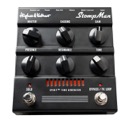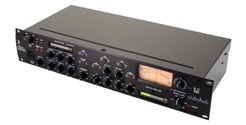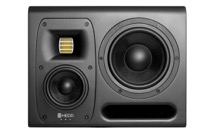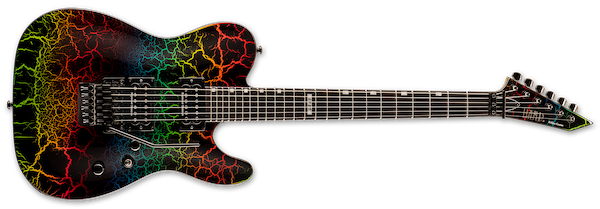FORWARD TO THE PAST! - Review ESP LTD Eclipse 87 Rainbow CRK
The concept of the ESP LTD Eclipse '87 Rainbow CRK Started many years ago as an inexpensive alternative to ESP Guitars, at a time when there was still a big gap in the manufacturing quality between the parent company and the LTD offspring, LTD has quietly blossomed into a consistently high-quality manufacturer in recent years. After moving away from Chinese production, the instruments, which are now mainly manufactured in Indonesia or like this ESP LTD Eclipse '87 Rainbow CRK in Korea, offer a good to very good price/performance ratio and in no way have to be considered a "second choice".
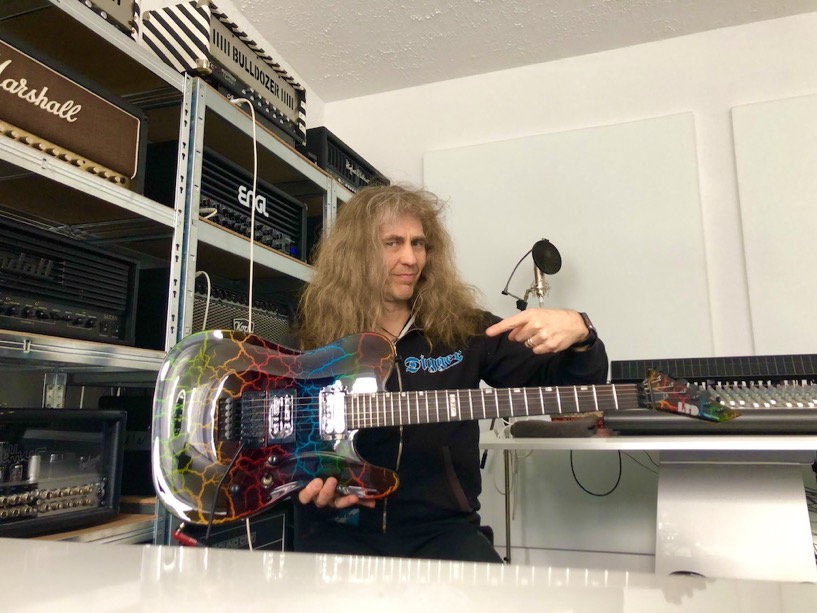
But why the big smile, as described at the beginning of the test report? Well, without a doubt, the Rainbow Crackle Finish used, alongside the eye cancer-promoting Neo Pink / Green / Yellow RG variants from Ibanez, are part of the optically ultimate 80s galore stock, which still warms the heart of every honorably gray cock rocker today . Once again it is pointless to give an optical rating for such a polarizing paint job, but I like the diametrical aspect of the optical concept. 50% of all guitarists will love the finish, 50% will hate it but 100% will talk about it, always a good effort from the marketing department I think.
There were not even that many manufacturers who offered this finish as a series model apart from the custom shops at the time, which could also be due to the comparatively greater effort involved in production. In the case of said painting, two painting steps with coordinated dissolving and drying steps are required in order to produce said crackle effect. I myself once involuntarily had a crackle effect on one of my self-painted stripes trademarks when, in complete naivety and ignorance, I applied white stripes to a black Explorer and then wanted to seal them with bold clear varnish. The clear coat dissolved the white streaks again, dried faster than the white paint and tore the white streaks when it contracted while drying. As far as I know, this is done today with icing spray, I am sure about this. but not quite sure.
What is certain, however, is that the rainbow stripes are painted on first, followed by an opaque black paint finish, which is then torn open again. The nice thing about it is that each paint finish is unique, since the "front view" can never be copied 1:1. It is also very nice that the finish extends over the entire instrument including the neck and the headstock.
The conception
When it comes to pickups, LTD relies on the proven combination of Seymour Duncan '59 on the neck and Seymour Duncan JB on the bridge, whereby both pickups can be split using the push/pull function of the Mastertone controller. As further control options, the instrument has a master volume control and a three-way switch. The two controls and the switch are of high quality, although I personally find the position of the three-way switch to be a bit unfortunate. It is difficult to reach due to the fact that it is relatively close behind the volume control when viewed from above, and there is a possibility that the neck pickup setting could inadvertently toggle the switch when operating the volume control. The vibrato arm positioned there also makes it more difficult to reach. However, this is a purely subjective assessment by a musician who has become accustomed to the toggle switch position of an LP over decades.
The ESP LTD Eclipse '87 Rainbow CRK is available in two versions, with and without a Floyd Rose 1000 vibrato system. As with almost all other instruments that have a Floyd Rose system, the ESP LTD Eclipse '87 Rainbow CRK also has the notorious "hall spiral" effect, which is based on the vibration of the springs of the vibrato block. If you want to better define your tone when playing hard staccato, you should put appropriate damping material such as foam around the springs. A nice detailed solution is once again the slotted cover plate on the back of the body, where you can change the spring tension using a Phillips screwdriver without having to remove the plate. An additional spring plus all necessary Allen keys are included with the instrument.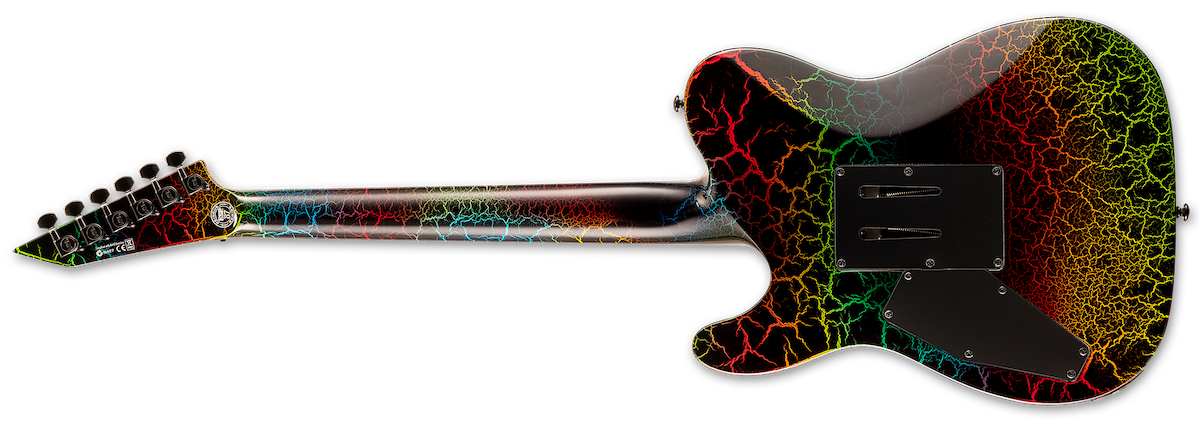
The ESP LTD Eclipse ´87 Rainbow CRK in practice
Once again, the combination of a neck-thru with a Floyd Rose vibrato system turns out to be the best compensation for the sustain loss caused by the vibrato system. The vibration behavior of the guitar is indeed very good and clearly noticeable even in the not amplified mode without any gain support. I couldn't find any dead notes or dying needs in the entire tonal spectrum, which in itself speaks for a successful coordination in the construction. The overall playing feel is very round and balanced, with the instrument showing great tonal flexibility.
Due to the splittable pickups, the ESP LTD Eclipse '87 Rainbow CRK does indeed cover a very wide range that goes far beyond the hard'n'heavy range that the instrument is expected to be capable of due to its visual appearance. Anyone who manages to hide the optics of the instrument, or to regard it as a neutral element of their personal performance, can cover almost all styles with a total of 6 basic sounds, which a broad portfolio takes up. The SD pickups once again do their job to their absolute satisfaction, especially since they have been installed countless times in this constellation. I would be interested to know if Jeff Back is aware of the huge success of his signature pickup.
All in all, the ESP LTD Eclipse '87 Rainbow CRK can do a lot more in the studio than you might think based on its looks. Always an eye-catcher, as long as personal self-confidence allows it.
Conclusion
With the ESP LTD Eclipse '87 Rainbow CRK, the manufacturer has a very flexible and optically polarizing guitar in its portfolio. With the eye-catching Rainbow Crackle finish, the guitar has a massive reminiscence of the eighties, which splits the user into two camps at first glance.
But you shouldn't be overwhelmed by the looks and keep an open ear for the high-quality and flexible sounds. which can be elicited from the "Powertele" due to the very good individual components. Besides, it really doesn't matter which color combination you want to wear on stage as an outfit, the ESP LTD Eclipse '87 Rainbow CRK definitely fits visually.
01-ESP LTD Eclipse 87 Rainbow CRK Clean SC-HB
02-ESP LTD Eclipse 87 Rainbow CRK Crunch 1 SC-HB
03-ESP LTD Eclipse 87 Rainbow CRK Crunch 2 SC-HB
04-ESP LTD Eclipse 87 Rainbow CRK Lead SC-HB
05-ESP LTD Eclipse 87 Rainbow CRK High Gain
For further information about the guitar, please check out THIS LINK and check your language at the upper right corner.
GET YOUR BEST PRICE AT MUSIKHAUS THOMANN OR AT AMAZON![]()
MORE PUNCH! How to mix metal properly! - Workshop Part 1 of 3
It polarizes like no other genre of music, metal. Even at the mention of the word, many music listeners immediately shut up, as they usually have exactly the subspecies in mind that repels them the most, not knowing that the generic term metal covers an almost inexhaustible wealth of ultra-low-tuned, sluggish rhythms extremely catchy pop arrangements to rabbit fuck high-speed shredding with chipmunk vocals. However, there are some special features that underlie almost all metal music styles, which we want to take a closer look at in this workshop in order to avoid as many mistakes as possible in the next metal production and to tease the maximum out of one's abilities.

What is important in metal mixing?
Let me get this clear, metal is an art form that is not about artistic expression, but about the realization of music, using all the "artificial" means available on the market. One or the other will ask what is so special about it. Well, while electronic music, for example, never claims to be analogously reproducible in any kind of people via traditional instruments using "handmade music", the classic metal fan still assumes that in the studio or on stage 4- 6 musicians record with their instruments what they are serving up to the listener at that very moment. Adjust the volume a bit, and the album is finished. This means that all changes that are made in the sound material with regard to the arrangement and craftsmanship of the individual artists should, at least in theory, be feasible live, so that it always has an "honest" character for the fan. The fact that live is now even more deceived and deceived than in the studio because of the backing tracks is another matter.
The reality could not therefore be more diametrically opposed. It is true that in the field of metal, compared to other music genres such as pop, dance or electro, a comparatively large amount of craftsmanship is used, but the same is completely subordinated to the one and only maxim and this is PUNCH! The problem is that every music listener defines the same term differently, but one thing is for sure, there are some points that need to be considered or fulfilled that something like punch can arise. Let's see.
ATTENTION! In this article I will give my personal opinion and the experiences I have gained in my career as a producer and instrumentalist. It's in the nature of things that some styles / bands / approaches / definitions come off better than others. So if I step on a fanboy's toes in this article because I didn't appreciate his preferred style of music or, in his opinion, misinterpreted it, I'm sorry.
Mix metal – the band itself
For the sake of simplicity, we'll assume a classic metal line-up that was called V, 2x G, B, Dr.. 40 years ago and is still there today. We leave out the abilities of the musicians in the overall context or as individuals in the area of songwriting, because you could fill 10 workshops in this area alone and you wouldn't even have seen the tip of the iceberg. So we say that the band has agreed on one or more songs and that the music and lyrics are in place.
Now, to give the song any kind of punch, the most important thing is that the entire band has perfect (not good, but perfect!) timing. The reason is simple physics. Even if we leave out the vocals, which usually have a "narrative function" and can therefore act rhythmically more freely, a downbeat, an emphasis or a continuous rhythm only has a corresponding pressure if all musicians hit the downbeat in the millisecond range. Nothing makes a production more sloppy than when 4 musicians play their intonations at 4 different times. That's why practicing the metronome is an absolute must, especially in metal.
Just a quick reminder, yes I know the timing of some of the stars of metal was disastrous in their early days and I'm not just talking about Lars Ulrich (but he has an estimated net worth of around 350 Mio...) but it's 2022. Nobody with today's possibilities, it still forgives a hopping drum set, a sluggish bass or driving, up speeding guitars. And yes, of course you can jerk instruments these days, but few have any idea what a disastrous effect that can have on the overall sound. More on that later. A tip from my experience regarding practicing the metronome. I always have the best experiences for myself when I don't "practice to the metronome" but imagine that I have to "lead" the metronome (which of course is complete nonsense). When I play "along with" the metronome, most of my concentration goes into listening to the metronome. As a result, I'm totally in the beat, but play comparatively insignificantly and without attitude. But if I "lead" the metronome, the metronome keeps me on a leash in terms of timing, but I play much more expressively and better.
Mix metal – the drums
OK, I'll be honest, maybe 1% of all metal productions worldwide are still made with the drums according to the drum / cymbal - microphone - preamp principle. Why? Because the effort for a high-quality sound with an acoustic drum set is gigantic! Not only do you need a huge set of microphones with the appropriate input channels on the console or interface, no, you also need a drummer who plays fantastically and who combines craftsmanship with perfect timing. In contrast to mono signals such as guitars / bass, etc., drums are much more difficult to cut because, for example, cymbals overhang or you have double triggers.
Anyone who has spent a day just jerking kick and snare to a beat quickly loses interest in the work, although the automation of this work, which some programs offer, has never delivered an acceptable quality, at least for me. Not everyone has the nerve, like on Metallica's black album, to adjust the drums for a month so that one can speak of a rhythm. Add to that the fact that miking drums along with the guitar is the most complex task you can imagine in terms of sound. Just the crosstalk (bleeding) of the individual drums and cymbals requires a great deal of specialist knowledge, not to mention the right spatial sound. High-quality drum recordings cost a tidy five-figure sum in a regular rental studio, so that most bands cannot afford this recording method.
Mix Metal – Libraries and MIDI
Therefore, working with libraries, which can be used in 3 different ways, has prevailed at least in metal in recent years. About 50% of all metal productions are programmed with regard to the drums on the keyboard, whereby it usually makes a very big difference whether the drummer does it himself or some nose who thinks he knows how a drummer should play. If you take for example the currently leading platform Superior Drummer 3 and add the right library, it is no longer possible to distinguish whether the drums were recorded or programmed when heavy metal banging is involved, also due to the countless “humanize” options.
If you want to accentuate your personal touch even more, you have 2 more options to bring a good to very good sound to HD for a smaller budget. You can record the drums on an e-drum set in MIDI and take the respective library in the studio via MIDI signals, or you can play the drums regularly in a room that sounds as neutral as possible, but pay particular attention to high-end recordings of the cymbals and the hi-hat, while the drums are only used for later triggering of the library and are therefore treated rather neglected in terms of sound. The triggering of cymbals has always turned out to be a weak point, which is why you should focus on this, preferably with individual pickup of the cymbals / hi-hat plus overhead. Since dynamics are generally used very rudimentarily in metal (or are completely destroyed in mastering anyway), the typical velocity range is always in the three-digit range, so that the fine work usually falls victim to the basic level anyway.
Most of the work will be to convince the drummer that this way of working benefits the band's budget and does not devalue him personally. Depending on the level of professionalism, this can happen very quickly or result in agonizing discussions. I therefore recommend every band leader to deal with this topic in good time, or to find more budget for the production.
Which drum sound is ultimately to be preferred cannot be said globally, since the possibilities would go beyond any workshop. Personally, however, I recommend getting rid of the notorious current snare/kick mixes, in which you can no longer perceive cymbals and certainly no hi-hat. Such a complex instrument as the drums work very interactively with regard to the individual sound generators, so for example. a kick shot without a cymbal is completely pointless.
If you like to get an example for a modern drum sound, check out this link!
In the next part of the series we turn to the areas of vocals and bass.
Maximum sound with minimum dimensions! - Review Hughes&Kettner StompMan
When the Hughes & Kettner company introduced the Spirit Tone Generator a few years ago together with their BS 200 series, a worldwide murmur went through the scene. Never before it has been possible to get so close to the sound of a vacuum tube with a transistor amplifier. Due to the patented, purely analogue circuit, the amplifier managed to bridge the gap between the light, inexpensive but also poorly-sounding transistor amplifiers to the top league of all-tube amplifiers in terms of sound, which unfortunately also have a high transport weight and, due to their components, have a significantly higher price .
It was immediately clear to me that this part would be a box office hit, but even I didn't expect the immense success of this amplifier series. Other products such as the Nano Heads or the AmpMan followed and, with the help of the Spirit Tone Generator, were able to deliver a significantly higher quality sound than what the retail price would suggest. But Hughes & Kettner wouldn't be Hughes & Kettner if they weren't constantly striving to expand and improve their portfolio, which is why the latest addition to the Spirit Tone Generator family is called StompMan and again comes with a number of very well thought-out and extremely practical ones Features would come up.
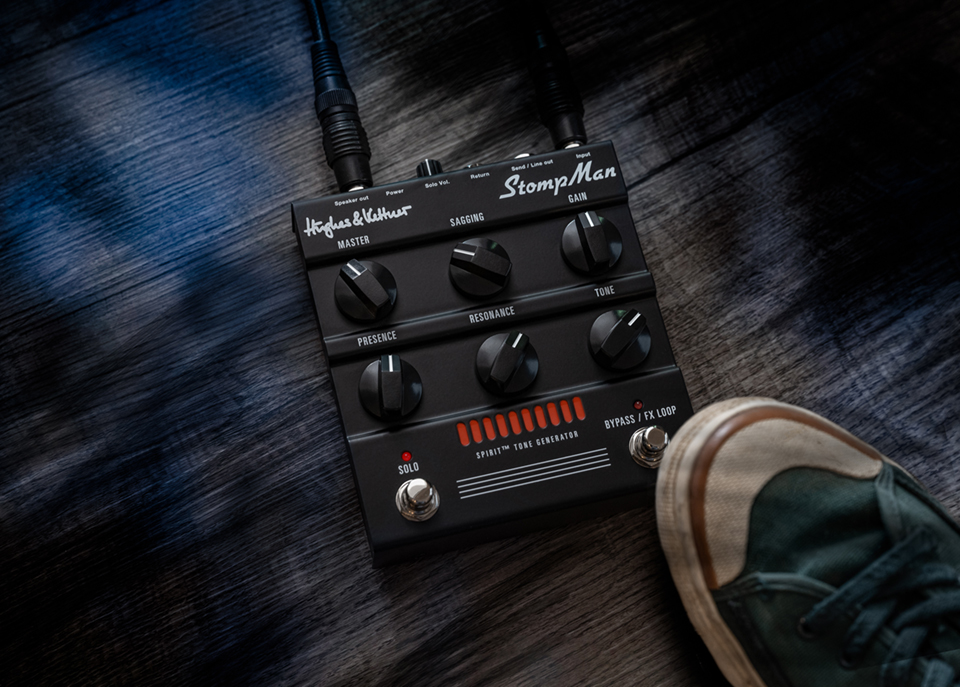
The structure of the Hughes & Kettner StompMan
The experienced reader will probably be able to guess for which application the Hughes&Kettner StompMan was designed after just a quick look at the layout of the amplifier in combination with its name. The dimensions of just (W x D x H): 132 mm x 52 mm x 153 mm and the weight of 650 g suggest that the amp was designed for floorboard use. In order to be able to operate the amp, on the other hand, the included power supply unit must be used, since the performance characteristics of 24 V and 2.5 A cannot be supplied by any multi-voltage power supply unit that is normally used in floorboard operation. But the whole thing shouldn't be a real problem, since the power supply was designed to be relatively flat and narrow and should therefore fit under most floorboards beyond the Nano / Mini series with 2 cable ties or the like. The power supply works worldwide due to its voltage processing of 100 - 240 volts.
The concept of the amplifier, designed as a single channel, is based on the AmpMan, which is characterized in terms of tone control by dispensing with a three-band tone control in favor of a tone controller. In addition to the master volume and the gain controller, the Hughes&Kettner StompMan offers three controllers from the power amp area, which are divided into the areas of resonance, presence and sagging. The sagging controller in particular is a unique selling point, as it emulates the saturation behavior of a tube power amp and can play to its strengths, especially in the crunch area.
The amp delivers 25 watts into 8 ohms, which is more than enough for a regular club gig. Since it is a transistor output stage, the power output varies depending on the impedance of the box, i.e. the amp offers almost 12.5 watts at 16 ohms, but 50 watts at 4 ohms. The Hughes&Kettner StompMan offers 2 footswitches, a solo switch with which the output level can be increased by up to +6 dB (adjustable via a potentiometer on the front) and a bypass switch whose function can be combined on the front with a mini switch FX-Loop toggle switch and we will go into its exact function in a moment.
The design of the amp The Hughes & Kettner StompMan, with its single-channel orientation in the stand-alone function, is based on the "more-or-less-clean" and distorted sounds of the 60s and early 70s, which can be found as a house number in the JMP and JCM area, or to put it another way, Clean is done with the volume control of the guitar and lead / high gain with an overdrive / distortion pedal connected in front of it. The gain range was designed to be rather moderate and focuses more on the power amplifier work, which can be varied very well with the sagging controller even at low volumes. If bypass is activated, gain and tone are taken out of the signal path, but presence, resonance and sagging are still available and deliver finely controllable tube power amp sound. So far everything is fine, but that alone would not necessarily be a strong argument for the amp, so we now come to the application examples of the amp!
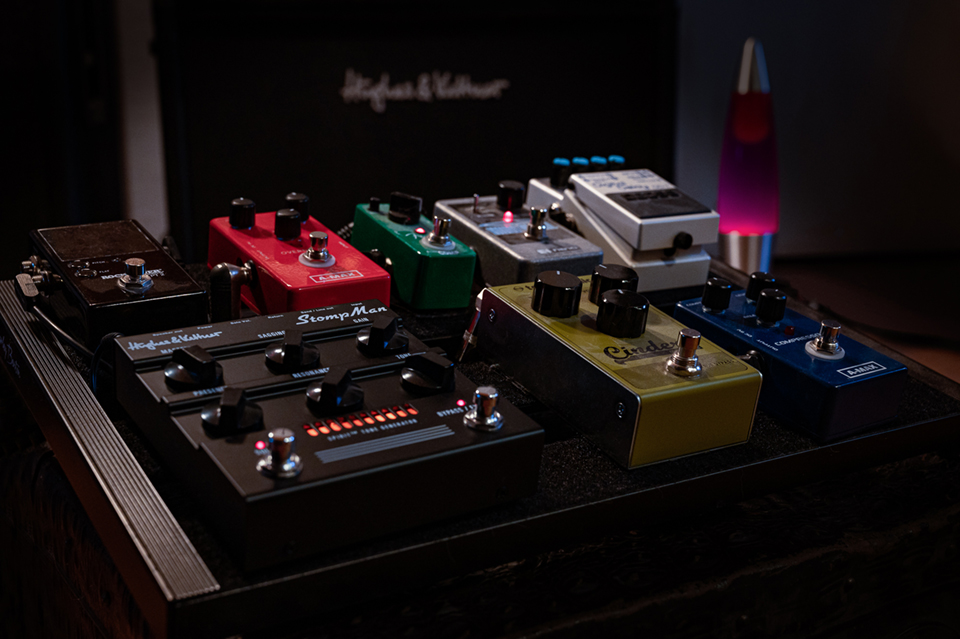
The application examples of the Hughes&Kettner StompMan
Unlike guitarists who need a modeller as an "all-in-one" solution, a typical pedal board player mostly wants a modular solution where they can express their individuality using their personal pedals. He may also want to connect additional preamps and, depending on the area of application, use separate speaker emulations for direct to FOH or in-ear applications and may also use external noise gates. Here the StompMan can help with a comparatively simple but ingenious setup:
1.) As a full-fledged single-channel amp
Use with booster, fuzz, overdrive, chorus, flanger etc. in front of the input, and reverb or delay effects in the loop is the main application of the Hughes&Kettner StompMan. Here the StompMan is used like a classic single-channel amp including pre- and power-amp sound parameters with a guitar box, with the convenience of a switchable FX loop and a clever solo function to relieve the FOH .
2) As a power amp (bypassing the internal preamp)
Thanks to the integrated bypass, the user does not need to "abuse" the FX return to bypass the internal preamp so that external preamps can be boosted. Bypass removes gain and tone from the signal path, the power amp sound parameters presence, resonance and sagging as well as the FX loop can still be used. To adjust the input level of the StompMan to the output level of the connected preamp, the StompMan offers a trim pot on the underside.
3) Recording via FX Send/Line and Software Cab-Sims
Whether with or without ballasts or preamps, the StompMan output labeled "FX Send / Line" picks up the signal directly in front of the master, so it already contains presence, resonance and sagging. Ideal for going into the line input of the DAW and using software cab sims and effects.
4) In Ear / Direct to FOH / FRFR
Appropriate hardware cab sims can be used for direct to FOH or in-ear applications. Instead of going into the return of the StompMan, at the end of the signal chain you simply go into the input of the Cab Sim and from its output to the console. It is still possible to use the power amp of the StompMan: if you connect the output of the Cab Sim to the return of the StompMan, its power amp amplifies the full-range signal of the Cab Sim FRFR boxes can be operated at the speaker-out of the StompMan.

The Hughes&Kettner StompMan in practice
In the practical part, I concentrated on the stand-alone operation of the amp, since the sound effects of external pedals would change the sound of the amp too much. The first thing that strikes you once again is that the tone control actually makes 80 - 90% of all three-band settings superfluous. On the contrary, the risk of an incorrect setting is massively reduced. Left stop has the typical British mid boost, right stop has a typical scoop alignment, everything in between is infinitely adjustable.
As with the big example of the Hughes & Kettner StomMan (I guess it's supposed to be a 2203), the tonal effectiveness is kept very moderate, i.e. even with long control paths the change in sound remains moderate. So you can z. B. like to set the Resonance control to the right stop without causing a lot of pumping, but that's exactly what makes u. the sonic appeal. Once again you have to keep in mind that this is not an all-tube amp, because the analog circuitry in combination with the sagging control makes it really difficult to filter out the difference in sound. The amp is highly dynamic, hangs very well on the guitar's volume control and offers the perfect basis for classic riffing in blues, rock and traditional hard rock.
For the American clean sound, the Hughes&Kettner StompMan also offers very variable options, for example I was very impressed by a clean gain setting with a strong sagging component. To hear the sagging effect in an A/B comparison, I recorded the same riff with and without sagging, the result speaks for itself. In conclusion, the StompMan can only be given top marks. The amp convinces with tiny dimensions with a very good sound, which is really, very close to the originals in the style of a 2203 or 2204, but has a significantly higher circuit flexibility, which again significantly increases the portability.
Hughes&Kettner StompMan - Clean
Hughes&Kettner StompMan - Crunch 1
Hughes&Kettner StompMan - Crunch 2
Hughes&Kettner StompMan - Humbucker No Sagging
Hughes&Kettner StompMan - Humbucker With Sagging
Conclusion
With the Hughes & Kettner StompMan, the German company has landed another big hit. The excellent-sounding amp impresses with a clever concept, which puts it in the front row of working musicians in terms of transportability and flexibility.
If you want to get the maximum sound out of your floorboard, you should definitely try the amp.
For further information about the amp, please check out THIS LINK and check your language at the upper right corner.
GET YOUR BEST PRICE AT MUSIKHAUS THOMANN OR AT AMAZON
And here we go!
No matter if you are a pro or a beginner, my aim is to inform you all around the world about the latest releases of all kind of toys and tools of the music business.
Please feel free to use the RSS link for your reader or simply check out the blog regularly and have fun! The first review will be online soon, so stay tuned.
Cheers
Axel

